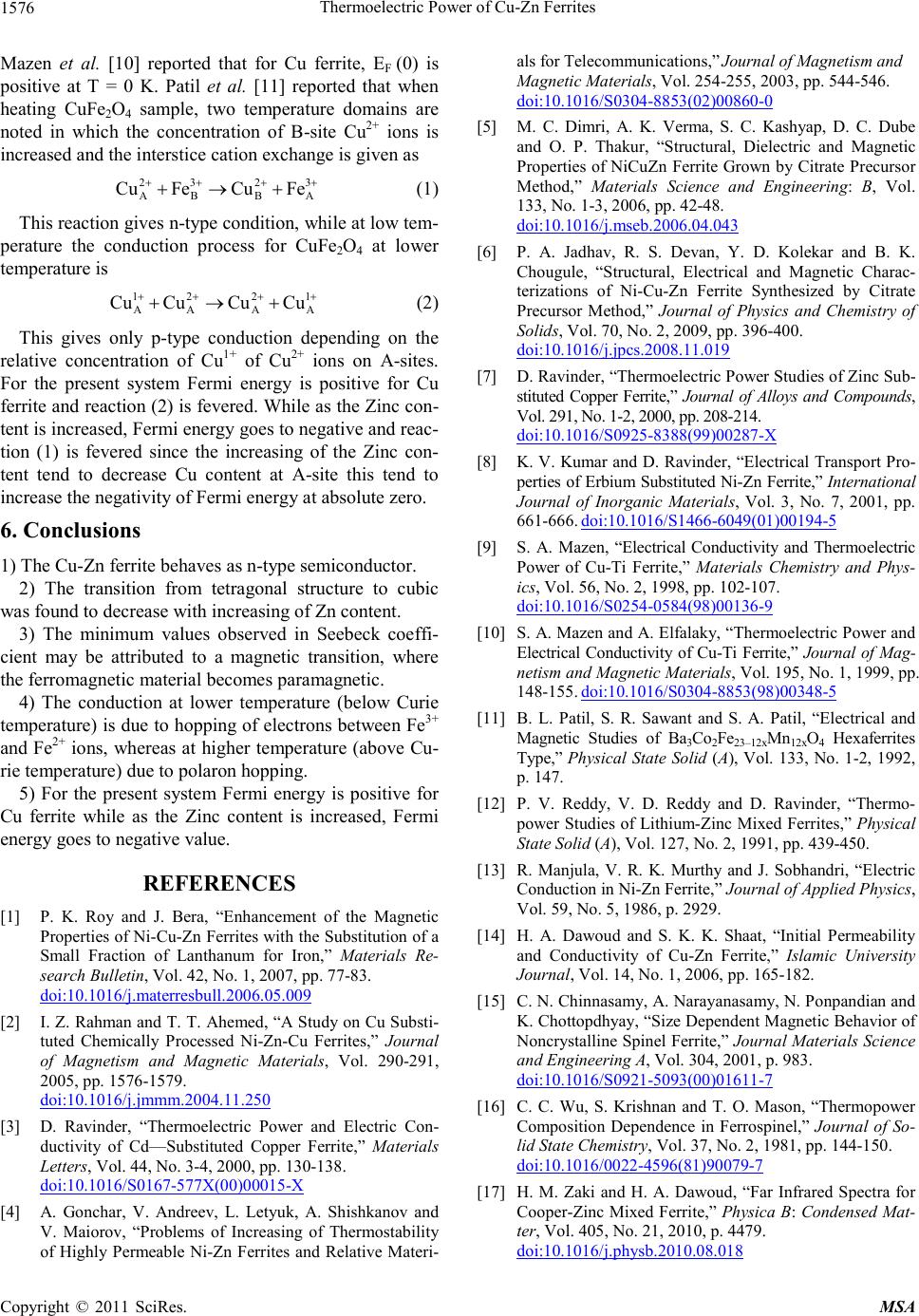
Thermoelectric Power of Cu-Zn Ferrites
1576
Mazen et al. [10] reported that for Cu ferrite, EF (0) is
positive at T = 0 K. Patil et al. [11] reported that when
heating CuFe2O4 sample, two temperature domains are
noted in which the concentration of B-site Cu2+ ions is
increased and the interstice cation exchange is given as
23 2
AB B
Cu FeCu Fe
3
A
1
A
(1)
This reaction gives n-type condition, while at low tem-
perature the conduction process for CuFe2O4 at lower
temperature is
12 2
AA A
Cu CuCuCu
(2)
This gives only p-type conduction depending on the
relative concentration of Cu1+ of Cu2+ ions on A-sites.
For the present system Fermi energy is positive for Cu
ferrite and reaction (2) is fevered. While as the Zinc con-
tent is increased, Fermi energy goes to negative and reac-
tion (1) is fevered since the increasing of the Zinc con-
tent tend to decrease Cu content at A-site this tend to
increase the negativity of Fermi energy at absolute zero.
6. Conclusions
1) The Cu-Zn ferrite behaves as n-type semiconductor.
2) The transition from tetragonal structure to cubic
was found to decrease with increasing of Zn content.
3) The minimum values observed in Seebeck coeffi-
cient may be attributed to a magnetic transition, where
the ferromagnetic material becomes paramagnetic.
4) The conduction at lower temperature (below Curie
temperature) is due to hopping of electrons between Fe3+
and Fe2+ ions, whereas at higher temperature (above Cu-
rie temperature) due to polaron hopping.
5) For the present system Fermi energy is positive for
Cu ferrite while as the Zinc content is increased, Fermi
energy goes to negative value.
REFERENCES
[1] P. K. Roy and J. Bera, “Enhancement of the Magnetic
Properties of Ni-Cu-Zn Ferrites with the Substitution of a
Small Fraction of Lanthanum for Iron,” Materials Re-
search Bulletin, Vol. 42, No. 1, 2007, pp. 77-83.
doi:10.1016/j.materresbull.2006.05.009
[2] I. Z. Rahman and T. T. Ahemed, “A Study on Cu Substi-
tuted Chemically Processed Ni-Zn-Cu Ferrites,” Journal
of Magnetism and Magnetic Materials, Vol. 290-291,
2005, pp. 1576-1579.
doi:10.1016/j.jmmm.2004.11.250
[3] D. Ravinder, “Thermoelectric Power and Electric Con-
ductivity of Cd—Substituted Copper Ferrite,” Materials
Letters, Vol. 44, No. 3-4, 2000, pp. 130-138.
doi:10.1016/S0167-577X(00)00015-X
[4] A. Gonchar, V. Andreev, L. Letyuk, A. Shishkanov and
V. Maiorov, “Problems of Increasing of Thermostability
of Highly Permeable Ni-Zn Ferrites and Relative Materi-
als for Telecommunications,” Journal of Magnetism and
Magnetic Materials, Vol. 254-255, 2003, pp. 544-546.
doi:10.1016/S0304-8853(02)00860-0
[5] M. C. Dimri, A. K. Verma, S. C. Kashyap, D. C. Dube
and O. P. Thakur, “Structural, Dielectric and Magnetic
Properties of NiCuZn Ferrite Grown by Citrate Precursor
Method,” Materials Science and Engineering: B, Vol.
133, No. 1-3, 2006, pp. 42-48.
doi:10.1016/j.mseb.2006.04.043
[6] P. A. Jadhav, R. S. Devan, Y. D. Kolekar and B. K.
Chougule, “Structural, Electrical and Magnetic Charac-
terizations of Ni-Cu-Zn Ferrite Synthesized by Citrate
Precursor Method,” Journal of Physics and Chemistry of
Solids, Vol. 70, No. 2, 2009, pp. 396-400.
do i:10. 1016 /j .jp cs.20 08. 11.0 19
[7] D. Ravinder, “Thermoelectric Power Studies of Zinc Sub-
stituted Copper Ferrite,” Journal of Alloys and Compounds,
Vol. 291, No. 1-2, 2000, pp. 208-214.
doi:10.1016/S0925-8388(99)00287-X
[8] K. V. Kumar and D. Ravinder, “Electrical Transport Pro-
perties of Erbium Substituted Ni-Zn Ferrite,” International
Journal of Inorganic Materials, Vol. 3, No. 7, 2001, pp.
661-666. doi:10.1016/S1466-6049(01)00194-5
[9] S. A. Mazen, “Electrical Conductivity and Thermoelectric
Power of Cu-Ti Ferrite,” Materials Chemistry and Phys-
ics, Vol. 56, No. 2, 1998, pp. 102-107.
doi:10.1016/S0254-0584(98)00136-9
[10] S. A. Mazen and A. Elfalaky, “Thermoelectric Power and
Electrical Conductivity of Cu-Ti Ferrite,” Journal of Mag-
netism and Magnetic Materials, Vol. 195, No. 1, 1999, pp.
148-155. doi:10.1016/S0304-8853(98)00348-5
[11] B. L. Patil, S. R. Sawant and S. A. Patil, “Electrical and
Magnetic Studies of Ba3Co2Fe23–12xMn12xO4 Hexaferrites
Type,” Physical State Solid (A), Vol. 133, No. 1-2, 1992,
p. 147.
[12] P. V. Reddy, V. D. Reddy and D. Ravinder, “Thermo-
power Studies of Lithium-Zinc Mixed Ferrites,” Physical
State Solid (A), Vol. 127, No. 2, 1991, pp. 439-450.
[13] R. Manjula, V. R. K. Murthy and J. Sobhandri, “Electric
Conduction in Ni-Zn Ferrite,” Journal of Applied Physics,
Vol. 59, No. 5, 1986, p. 2929.
[14] H. A. Dawoud and S. K. K. Shaat, “Initial Permeability
and Conductivity of Cu-Zn Ferrite,” Islamic University
Journal, Vol. 14, No. 1, 2006, pp. 165-182.
[15] C. N. Chinnasamy, A. Narayanasamy, N. Ponpandian and
K. Chottopdhyay, “Size Dependent Magnetic Behavior of
Noncrystalline Spinel Ferrite,” Journal Materials Science
and Engineering A, Vol. 304, 2001, p. 983.
doi:10.1016/S0921-5093(00)01611-7
[16] C. C. Wu, S. Krishnan and T. O. Mason, “Thermopower
Composition Dependence in Ferrospinel,” Journal of So-
lid State Chemistry, Vol. 37, No. 2, 1981, pp. 144-150.
do i:10. 1016 /00 22- 4596 (81 )9007 9-7
[17] H. M. Zaki and H. A. Dawoud, “Far Infrared Spectra for
Cooper-Zinc Mixed Ferrite,” Physica B: Condensed Mat-
ter, Vol. 405, No. 21, 2010, p. 4479.
doi:10.1016/j.physb.2010.08.018
Copyright © 2011 SciRes. MSA